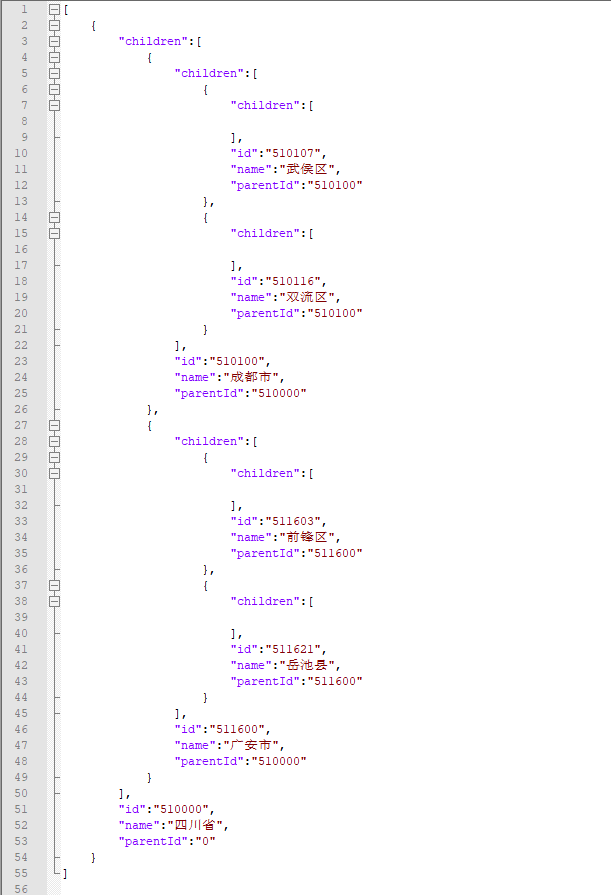
Manchmal sind unsere Daten hierarchisch. Beispielsweise ist die gemeinsame dreistufige Verknüpfung von Provinzen und Gemeinden eine Ebene in der anderen, wie unten gezeigt:

Und wir speichern Daten manchmal in der Datenbank. Es liegt oft in Form einer Liste vor, wie unten gezeigt:

Wenn wir es dann aus der Datenbank abfragen und an das Frontend zurückgeben und das Frontend die Baumebene angeben muss, können wir dieses Mal möglicherweise Sie müssen es rekursiv in eine Baumstruktur verarbeiten, daher kann das folgende Tool hilfreich sein.
Wir definieren ein Place-Objekt wie oben und fügen Werkzeuganmerkungen hinzu:
@TreeKey identifiziert die eindeutige
@TreeParentKey identifiziert die Identifizierung des übergeordneten Knotens
@TreeChildren identifiziert die Sammlung von Nachkommenknoten
@Data
@Data
public class Place {
@TreeKey
private String id;
@TreeParentKey
private String parentId;
private String name;
@TreeChildren
private List<Place> children;
public Place(String id, String name, String parentId) {
this.id = id;
this.name = name;
this.parentId = parentId;
}
}Test:
public class Test {
public static void main(String[] args) {
List<Place> places = new ArrayList<>();
places.add(new Place("510000", "四川省", "0"));
places.add(new Place("510100", "成都市", "510000"));
places.add(new Place("510107", "武侯区", "510100"));
places.add(new Place("510116", "双流区", "510100"));
places.add(new Place("511600", "广安市", "510000"));
places.add(new Place("511603", "前锋区", "511600"));
places.add(new Place("511621", "岳池县", "511600"));
List<Place> treeList = TreeUtils.getTree(places, "0");
System.out.println(JSON.toJSONString(treeList));
}
}Endeffekt:

@TreeKey
import java.lang.annotation.ElementType;
import java.lang.annotation.Retention;
import java.lang.annotation.RetentionPolicy;
import java.lang.annotation.Target;
@Target(ElementType.FIELD)
@Retention(RetentionPolicy.RUNTIME)
public @interface TreeKey {
}@TreeParentKey
import java.lang.annotation.ElementType;
import java.lang.annotation.Retention;
import java.lang.annotation.RetentionPolicy;
import java.lang.annotation.Target;
@Target(ElementType.FIELD)
@Retention(RetentionPolicy.RUNTIME)
public @interface TreeParentKey {
}@TreeChildren
import java.lang.annotation.ElementType;
import java.lang.annotation.Retention;
import java.lang.annotation.RetentionPolicy;
import java.lang.annotation.Target;
@Target(ElementType.FIELD)
@Retention(RetentionPolicy.RUNTIME)
public @interface TreeChildren {
}@TreeUtils
package com.csd.utils.tree;
import java.lang.reflect.Field;
import java.util.ArrayList;
import java.util.Collections;
import java.util.List;
import java.util.Objects;
/**
* 递归求树形工具类
*
* @author Yuanqiang.Zhang
* @since 2023/3/8
*/
public class TreeUtils {
/**
* 集合转化为树形
*
* @param list 集合
* @param highestParentKey 最高层父节点值
* @param <T> 泛型
* @return 树形
*/
public static <T> List<T> getTree(List<T> list, Object highestParentKey) {
if (Objects.isNull(list) || list.isEmpty()) {
return Collections.emptyList();
}
Field key = null;
Field parentKey = null;
Field children = null;
Field[] fields = list.get(0).getClass().getDeclaredFields();
for (Field field : fields) {
if (Objects.isNull(key)) {
TreeKey treeKey = field.getAnnotation(TreeKey.class);
if (Objects.nonNull(treeKey)) {
key = field;
continue;
}
}
if (Objects.isNull(parentKey)) {
TreeParentKey treeParentKey = field.getAnnotation(TreeParentKey.class);
if (Objects.nonNull(treeParentKey)) {
parentKey = field;
continue;
}
}
if (Objects.isNull(children)) {
TreeChildren treeChildren = field.getAnnotation(TreeChildren.class);
if (Objects.nonNull(treeChildren)) {
children = field;
continue;
}
}
}
if (Objects.isNull(key) || Objects.isNull(parentKey) || Objects.isNull(children)) {
return Collections.emptyList();
}
key.setAccessible(true);
parentKey.setAccessible(true);
children.setAccessible(true);
// 获取最高层数据
List<T> highs = new ArrayList<>();
try {
for (T t : list) {
Object pk = parentKey.get(t);
if (getString(pk).equals(getString(highestParentKey))) {
highs.add(t);
}
}
// 获取最高层子孙节点
for (T t : highs) {
setChildren(list, t, key, parentKey, children);
}
} catch (IllegalAccessException e) {
e.printStackTrace();
}
return highs;
}
/**
* 获取子孙节点
*
* @param list 集合
* @param parent 父节点对象
* @param key 唯一属性
* @param parentKey 父唯一属性
* @param children 节点
* @param <T> 泛型
* @return 带有子孙集合的父节点对象
* @throws IllegalAccessException
*/
private static <T> T setChildren(List<T> list, T parent, Field key, Field parentKey, Field children) throws IllegalAccessException {
Object k = key.get(parent);
List<T> tempList = new ArrayList<>();
for (T t : list) {
Object pk = parentKey.get(t);
if (getString(k).equals(getString(pk))) {
tempList.add(setChildren(list, t, key, parentKey, children));
}
}
children.set(parent, tempList);
return parent;
}
/**
* 获取字符串
*
* @param o 值
* @return 字符串
*/
private static String getString(Object o) {
return Objects.isNull(o) ? "" : o.toString();
}
}Das obige ist der detaillierte Inhalt vonSo verwenden Sie Rekursion, um eine Baumstruktur-Toolklasse in Java zu implementieren. Für weitere Informationen folgen Sie bitte anderen verwandten Artikeln auf der PHP chinesischen Website!




